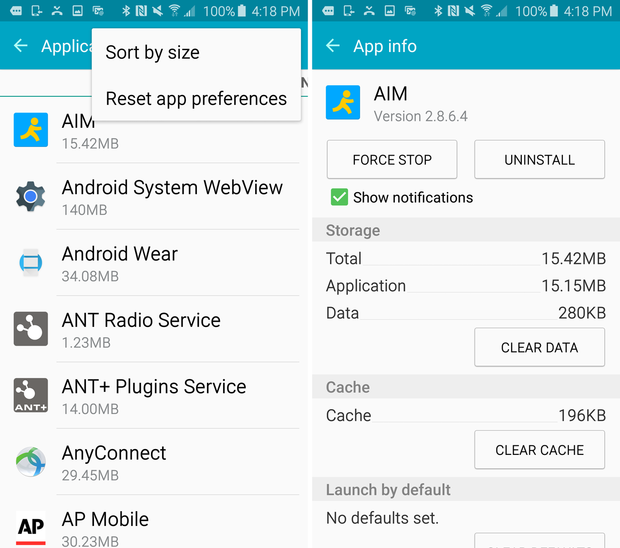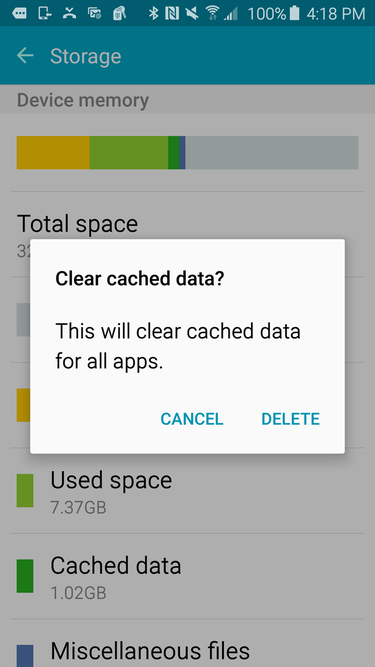Samsung 9 How to Get Messages to Say Read
How to fix the 'bereft storage' error in Android and iOS
Larn how to fix 'bereft storage' errors in Android and iOS, and get all your Os and app updates ASAP

- When Android shows the "Insufficient Storage Bachelor" mistake
- When iOS won't install an Os update for lack of space
Show More
We all know that storage is never much as to appears to be. A device with 32GB of storage, of example, volition have a lot less because of the operating system and preinstalled apps, as well as from the wasted space caused by how OSes format the storage medium.
Near of us know that, but we still get angrily mystified when we try to install apps or Os updates onto our Android or iOS device, only exist told there's insufficient room -- though the update or app takes far less space than what is available.
Blame it on poor UI: In well-nigh cases, what's really going on is that the Bone has bereft working infinite to perform the installation. There's enough room at the terminate of process for the update or app, but not enough to execute the procedure. If only the fault message but said so!
When Android shows the "Insufficient Storage Available" error
Lack of working space is the cause of the "Insufficient Storage Available" mistake that periodically bedevils Android users. Calculation insult to injury, there are several possible causes for the lack of sufficient working storage.
Android apps utilize 3 sets of storage space: for the apps themselves, for the apps' data files, and for the apps' cache. Those caches can grow quite big, yet they are reported every bit free space by Android -- though in fact that infinite is not available equally a working space for app installation.
If you go the "Insufficient Storage Available" mistake, empty your app enshroud to see if that clears upward enough working space for the installation. How to exercise so depends on what version of Android yous are running, as well as from what device maker. (The screens here are for Android Lollipop running on a Samsung Milky way S6.)
In most cases:
- Open the Settings app, tap Apps, Applications, or Applications Manager option. (Applications Director might be an selection subsequently either Apps or Applications.)
- Scroll sideways to the Downloaded section. Y'all'll see a list of all apps and how much storage space they're taking.
- Tap the Carte or More push button and choose Sort By Size to adjust the apps by which take the about storage.
- Tap an app to see how much storage it is taking, both for the app and its data (the Storage section) and for its cache (the Cache section).
- Tap Clear Cache to remove its cache and gratis upwardly that space. You could also tap Clear information, but that removes your files, which is probably a bad thought.
- Repeat for each app.

The Android Settings app shows the storage used past each app and lets yous purge each app'due south cache.
In some devices, at that place's a faster way to articulate all the apps' cache in one fell swoop:
- Open the Settings app, tap Storage (it should be in the Organisation tab or section). Y'all'll meet how much storage is used, with details for cached data cleaved out.
- Tap Cached Data. In the confirmation form that appears, tap Delete to free upwards that enshroud for working infinite, or tap Cancel to exit the cache alone.

In some cases, Android can purge all apps' caches in one fell swoop, using the Storage screen in the Settings app.
Be warned that immigration the cache may not practice the trick in all cases. Android devices that employ external storage (SD cards, basically) often accept much less usable storage than is reported. That'southward considering many system resources and some apps must be installed on the device's congenital-in core storage, not on a removable storage medium.
In that location are security and stability reasons for this requirement, but they've varied from one Android version to the next, and in some versions app makers become to decide the rules for what tin can be stored where. As a result, Android devices with removable storage may need to have apps and information removed to make room for updates and new apps -- not only the cache.
But what taketh likewise tin giveth: If an app can removed from internal storage to external storage, do so to free up the internal storage for use as working space for your app installation. If an app tin exist moved to external storage, you'll meet the Movement to SD Card button in the Applications Manager for that app.
Most Android devices that support external storage usually have too piddling internal storage (to get to a cheaper price). Thus, yous may not be able to install what you think y'all have room for, even later on cleaning upward the internal space. Next time, get a device with at least 32GB of internal storage.
When iOS won't install an Bone update for lack of space
iOS is much less decumbent to running out of room for app updates than Android, since apps' cache is contained in the same sandbox as the app itself and its data. iOS walls off each app for security reasons, so in that location is no purported free space where cache really resides. Thus, iOS knows if it has enough retention to install an app earlier it even tries.
Well, well-nigh of the time -- you might remember the frustration when iOS 7 came out in fall 2013, equally many users who tried to download the OS update over the air either got an error bulletin saying they had insufficient infinite or saw the update get stuck in Update Requested status. Basically, their update never progressed.
These users had enough space for iOS seven itself, but non enough working space to install information technology while iOS 6 was too running. Apple slimmed the space requirements for the iOS 8 updates, but some people still did not have enough space.
At that place are two solutions for this issue in iOS:
Delete apps and/or their data until there'south enough room for the over-the-air update (you lot need about 6GB of complimentary space). To delete an app:
- Tap and hold on one in the home screen; the app icons will start fluctuant.
- Tap the X icon on each app you want to remove, and so tap OK in the confirmation form. The app and all its files and other data are removed.
- Printing the Abode button when washed. The wiggling volition stop.
To remove files in apps' sandboxes, such equally storage-intensive videos:
- Open the Settings app.
- Tap General, then tap Usage.
- In the Usage screen, tap Manage Storage and wait a few seconds for a list of apps and their storage usage to appear.
- If you encounter the > icon to the correct of an app proper name, you can delete its files. Tap > to open up a screen showing those files.
- Tap Edit in the upper right, then tap the Delete icon (the ruby circle with a minus sign in information technology) for each file you lot want to delete. Go along in mind that if you hadn't backed up that file to iTunes, it'due south probable gone -- iCloud Backup doesn't preserve apps' files, though iTunes purchases similar videos and e-books can be redownloaded at no accuse.
- Tap Done when done.

The iOS Settings app lets yous delete individual files from many apps, using the Manage Storage screens in the General department.
Source: https://www.computerworld.com/article/3218152/how-to-fix-insufficient-storage-issues-in-android-and-ios.html
0 Response to "Samsung 9 How to Get Messages to Say Read"
Enregistrer un commentaire